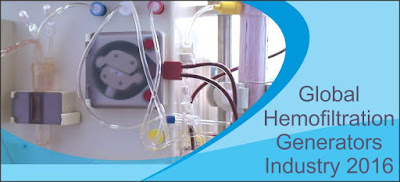Hemofiltration Generators are
machines used in hemofiltration procedure which is a therapy very similar to
hemodialysis. This process is used in case of renal failure as a substitute to
the function of kidneys. As compared to hemodialysis, hemofiltration is more
often than not used in case of severe and acute renal failure or acute kidney
injury (AKI) and that too in intensive care settings. The procedure involves
the patient’s blood to pass through the hemofiltarion generators which separates
out water and waste products from the blood and then adds the replacement fluid
(a fluid to preserve the blood volume and supplies electrolytes) just before
injecting the treated blood back to the patient’s body.
Hemofiltration is a prolonged,
lengthy and uninterrupted process which generally needs 12 to 24 hours per
session and is performed on a regular basis for as much as needed depending on
the patient’s condition. Also, acute renal failure can be reversed effectively
if the diagnosis is done at an early stage with an immediate appropriate
treatment. The hemofiltration generators work slightly different from that of
the machines used in hemodialysis, meaning the filtration method of both these
machines are different. While both the methods involve a use of semi-permeable
membrane to filter the blood, hemofiltration generators use convectional heat
along with diffusion. The convectional heat enables positive pressure of the
fluid to thrust out solutes and water via the filtering membrane, and therefore
the hemofiltration generators are more effective than that of a hemodyliasis
machine. The heat mechanism of the machine solves the underlying problem in
diffusion alone by enabling the filtration of solutes of various sizes at a
similar rate; and this rate of blood filtration of differently-sized solutes
are balanced with the help of hemofiltration and dialysis one behind the other.
It is a procedure which is termed as hemodiafiltration.
Different Functions of a
Hemofiltration Generator:
·
To
imitate the physiology and functions of the native organ
·
Repairing
and maintaining of homeostasis
·
Qualitative
and quantitative blood purification
·
Avoid
complex and good clinical tolerance
·
Render
conditions preferring the early recovery of renal function
Presently, there is an elevated
demand of hemofiltration generators on a global level. This is owing to a few
key factors such as rise in the number of acute kidney injuries (AKI), rising
geriatric population with increasing number of ICU patients. Nonetheless, the
complicated procedure and its cost per session, along with strict regulations
and insufficiency of trained ICU nurses in the United States are hindering the
market growth.

No comments:
Post a Comment